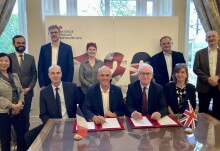

Imperial scientists document recent field trip to Oman, and the work they are carrying in $70 million international research project, in new video <em>– News</em>
See also:
Wednesday 14 April 2010
By Colin Smith
A research trip to a Middle Eastern desert, documented in a new video, has given a group of scientists from Imperial College London some new insights into how to store the greenhouse gas COâdeep underground.
The team visited the deserts of Oman in January as part of a field trip to learn more about the rocks in that area. They explored rocky desert outcrops on the surface of Oman that run deep underground to the neighbouring country of Qatar. At present, these rocks naturally store enough natural gas to supply the UK for the next 200 years.
The researchers are interested in the way in which these rocks store CO2 because they are investigating the potential of a process known as Carbon Capture and storage, where COâ is stored in depleted reservoirs deep underground to reduce the amount of greenhouse gas that is released into the atmosphere.

The field trip was part of a $70 million ten year collaborative project between Imperial’s Departments of Chemical Engineering and Chemical Technology and Earth Science and Engineering, Qatar Petroleum and Shell International. The project is looking at CCS and also at developing a deeper understanding of gas reserves in the Qatar region so that gas can be extracted more efficiently and effectively.
In the video (right), which was made by the researchers during their time in Oman, the team talk about how analysing rocky outcrops is giving them a unique understanding of how it might be possible to store CO2 in the depleted gas reservoirs in Qatar.
-Ends-
Article text (excluding photos or graphics) available under an Attribution-NonCommercial-ShareAlike Creative Commons license.
Photos and graphics subject to third party copyright used with permission or © Imperial College London.





